
What Should You Pack If You’re Enrolling In An Inpatient Program?
Inpatient treatment, otherwise known as residential rehab, requires its residents to enroll in a 30-90 day program. How long someone will be enrolled in a residential program depends on the severity of their addiction to drugs or alcohol.
Since inpatient rehab requires you to live in a completely different environment than what you’re used to, you may not know exactly what to expect upon enrolling. If you’re getting ready to begin a residential program, it’s understandable for you to have some questions — one of the most prominent ones being: what should you bring with you?
Getting Ready for Rehab
Depending on the rehab you’re attending at the program you’re enrolling in, you may receive a checklist of what you can and cannot bring into the facility with you. But if they don’t provide a list, you are encouraged to call the rehab center to see which items your program allows.
Rehabilitation facilities typically offer a majority of one’s necessities, like toiletries and nourishment. However, there are some things that you will be allowed to bring from home.
What to Bring With You to Rehab
Here are some items that most rehab facilities allow or encourage their inpatient residents to bring with them:
- Clothes – bring some seasonal and comfortable clothes, including pajamas
- Laundry supplies – on the same note, you should bring detergent and other supplies to clean the clothes you bring with you
- Shoes – bring along some slip-on shoes, boots without laces, and flip flops (for showers)
- Toiletries – while rehabs have the basics, you are welcome to bring personal items like toothpaste, lotion, shampoo/conditioner, and deodorant)
- Hair dryer – feel free to pack a hair dryer and other approved hair products
- Medications – make sure all prescriptions are correctly labeled upon your arrival
- Identification info – make sure you have your identification and insurance cards with you when you check in
- Money – have a checkbook or credit card handy to pay for treatment or other necessities
- Sentimental items – bringing a teddy bear or photo of someone can help patients cope
- Comfort items – physical comfort items, such as blankets, are welcome in rehabs
- A journal or notebook – bring something you can record your thoughts in. This will help you to reflect on both during and after your rehab experience.
- Contact info of loved ones – make sure you record your loved ones’ addresses so you can write to them while enrolled in rehab
- Envelopes and stamps – in the same vein, bring along some stamps and envelopes to send letters to your family members and friends
Things to Leave at Home
On the other hand, here are some items that your rehab facility may not allow you to bring:
- Jewelry
- Technology items (phone, computer)
- Razors
- Mouthwash
- Perfume
- Shoes with laces
These policies are in place for the safety of residents and faculty or staff at the rehabilitation facility.
Easing Into Your Inpatient Program
Entering a rehab facility may come with some culture shock, but it’s important to get used to a new environment in order to succeed with sobriety. At the end of the day, programs like this are designed to prepare you with the tools you need to recover in the real world when you leave the facility. Inpatient treatment will likely consist of one-on-one therapy, group meetings, medication, wellness activities, and more.
To learn more about what to expect from a residential rehab program, contact our team of substance abuse professionals by calling 267.719.8528.
Sources
https://www.goodtherapy.org/learn-about-therapy/treatment-centers/bring-to-rehab
https://vertavahealth.com/blog/what-should-i-bring-to-rehab/
Explore this article:
Explore Our Facilities
Drug and alcohol detox and residential treatment for addiction and mental health disorders
Outpatient treatment center for substance use disorder and mental health disorders
Outpatient treatment center for substance use disorder and co-occurring mental health disorders







